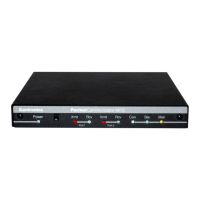KPC-9612 Version 5.2 July 19, 1994
56
The purpose of the pins (by name) is:
FG FRAME GROUND: This pin is attached to the chassis of the equipment as a safety ground.
Txd TRANSMIT DATA: This line carries the data from your computer to the KPC-9612.
Rxd RECEIVE DATA: This line caries the data from the KPC-9612 to your computer.
RTS REQUEST TO SEND: The KPC-9612 checks this line to see if it is permitted to send data to
your computer. This pin is controlled by your computer software program to provide this in-
formation to the KPC-9612. This pin is used for hardware flow control.
CTS CLEAR TO SEND: The KPC-9612 uses this line to signal your computer when it can no lon-
ger accept data from the computer, or to signal that it is again ready to accept data. This
pin is used for hardware flow control.
DSR DATA SET READY: This line is connected to the DTR line inside the KPC-9612. Some soft-
ware may require a positive voltage on this pin in order to detect the presence of a mo-
dem. If your computer supplies a positive voltage on its DTR pinwhen operating, this volt-
age will also appear as a return signal to your computer on the DSR pin. if your computer
does not supply a positive voltage on the DTR pin, you may install a 10K ohm resistor at R-l
on the KPC-9612 to supply this signal.
DCD DATA CARRIER DETECT: The KPC-9612 uses this pin to signal the status of the current I/O
stream to your computer. If you are currently connected to another packet station, this line
will have a positive voltage on it. If you are disconnected, the voltage on this line will be
negative.
DTR DATA TERMINAL READY: This line is connected to the DSR line inside the KPC-9612 and is
not used by the KPC-9612 for any purpose.
Options
There are several options provided for wiring the KPC-9612 serial port through the use of internal
jumpers. See the section on Junipers in this manual for details on these options.
Software settings
When using a standard terminal program to communicate with the KPC-9612, we recommend you
set the serial port configuration in your program for 8 data bits, no parity, and one stop bit. The
baud rates supported by the KPC-9612 are 300, 600, 1200, 2400, 4800, 9600 and 19200. In gen-
eral you should use the fastest baud rate your terminal program supports (up to 19200). The KPC-
9612 defaults with ECHO ON, so you should set your terminal program for "full-duplex" operation.
If you are using a baud rate above 4800 baud, we strongly recommend that you consider installing
special high-speed, buffered UARTS in the serial port of your computer. These UARTS are available
through many parts suppliers and will improve the reliability of high-speed communications. You
should ask for the "high-speed buffered UARTS" (part number 16550 or equivalent) when ordering
from your supplier.

